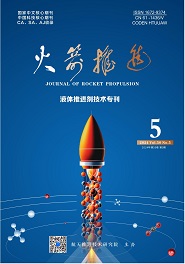航天推进技术研究院主办
ZHANG Hao,WANG Shuai,ZHUAN Rui,et al.Effect of subcooled degree on performance of thermodynamic vent system in spacecraft tank[J].Journal of Rocket Propulsion,2020,46(04):74-81.
过冷度对飞行器贮箱热力学排气系统性能的影响
- Title:
- Effect of subcooled degree on performance of thermodynamic vent system in spacecraft tank
- 文章编号:
- 1672-9374(2020)04-0074-08
- Keywords:
- cryogenic tank; thermodynamic vent; subcooled degree; pressure control
- 分类号:
- V511.6
- 文献标志码:
- A
- 摘要:
- 为了研究低温推进剂贮箱的压力控制特性和热力学排气系统的运行特性,建立了耦合贮箱内流体流动相变过程与热力学排气系统(TVS)的数学模型,对TVS系统运行后贮箱的压力和温度变化进行了仿真计算。在以液氮为贮存工质的低温流体高效贮存平台上,进行了仿真模型的验证。分析了不同液体过冷度对低温贮箱温度和压力控制特性的影响。研究发现,在相同的在轨贮存周期内,对于饱和状态的液氢和液氧,TVS只有在排气模式下才能实现低温贮箱的压力控制,而对于过冷状态的液氢和液氧,TVS只需进行混合模式运行便可实现低温贮箱压力控制,且TVS混合运行时间随液体过冷度的增加而减少,16 K液氢时TVS的运行时间(546 s)相比于20 K液氢(663 s)减少了17.6%,78 K液氧时TVS的运行时间(2 760 s)相比于90 K液氧(16 469 s)减少了83.2%。过冷液体与气枕的混合可以实现低温流体在轨贮存过程中的零排放。
- Abstract:
- In order to investigate the pressure control behavior of cryogenic propellant tank and operating performance of thermodynamic vent system(TVS), a mathematical model coupling both the fluid flow phase change in the tank and the thermodynamic vent subsystem was established, and the tank self-pressurization process and the tank pressure control effect under the operation of TVS were simulated.In the cryogenic fluid storage platform using liquid nitrogen as the working medium, the tank pressure control experiment was conducted to verify the simulation model.The influence of subcooled degree on the temperature and pressure control of the cryogenic tank was analyzed.It is found that during the same in-orbit storage period, for the saturated LH2-LO2 propellant, the tank pressure can only be controlled with the vent mode of TVS.For the LH2-LO2 propellant in subcooled state, the TVS only need operating in the mixing mode to control the tank pressure.Moreover, the mixing operation duration deceases with the increase of the liquid subcooled degree, and TVS takes 17.6% less operation time(546 s)at 16 K liquid hydrogen than at 20 K liquid hydrogen(663 s).The operation time of TVS at 78 K liquid oxygen(2 760 s)is 83.2% less than that at 90 K liquid oxygen(16 469 s).Zero discharge of cryogenic fluid during in-orbit storage can be achieved by mixing the subcooled liquid and the superheated ullage.
参考文献/References:
[1] 仲伟聪.液氧/甲烷液体火箭发动机燃烧研究最新进展[J].火箭推进, 2004, 30(1): 52-57.ZHONG W C.Recent advances on LOX/methane combustion for liquid rocket engine[J].Journal of Rocket Propulsion, 2004, 30(1): 52-57.
[2] 马冬英, 卢钢, 张小平, 等.液氧/甲烷燃气发生器试验研究[J].火箭推进, 2013, 39(3): 21-26.MA D Y, LU G, ZHANG X P, et al.Research on hot tests of LOX/methane gas generator[J].Journal of Rocket Propulsion, 2013, 39(3): 21-26.
[3] SORENSEN G L, NIGGEMANN R E, BASSETT C E, et al. A zero-gravity thermodynamic vent system for the shuttle/centaur hydrogen tank[C]//SAE Technical Paper Series. 400 Commonwealth Drive, Warrendale, PA, United States: SAE International, 1984.
[4] HILL D E, SALVINSKI R J. A thermodynamic system for zero-g venting, storage, and transfer of cryogenic propellants[J]. Journal of Spacecraft and Rockets, 1967, 4(7): 955-957.
[5] FLACHBART R, HASTINGS L, MARTIN J. Testing of a spray bar zero gravity cryogenic vent system for upper stages[C]//35th Joint Propulsion Conference and Exhibit. Los Angeles, CA, USA. Reston, Virigina: AIAA, 1999.
[6] FLACHBART R, HASTINGS L, MARTIN J.Testing of a spray bar zero gravity cryogenic vent system for upper stages[C]// The 35th Joint Propulsion Conference and Exhibit.Los Angeles, CA:AIAA, 1999.
[7] FLACHBART R, HASTINGS L, HEDAYAT A.Spray bar zero-gravity vent system for on-orbit liquid hydrogen storage[R].NASA/TM-2003-212926, 2003.
[8] HEDAYAT A, BAILEY J, HASTINGS L.Test data analysis of a spray bar zero-g liquid hydrogen vent system for upper stages[C]// The 35th Joint Propulsion Conference and Exhibit.Los Angeles, CA:AIAA, 1999.
[9] FLACHBART R, HASTINGS L, HEDAYAT A, et al.Testing the effects of helium pressurant on thermodynamic vent system performance with liquid hydrogen[J].Advances in Cryogenic Engineering, 2008, 985(1):1483-1490.
[10] HASTINGS L, BOLSHINSKIY L, HEDAYAT A, et al.Liquid methane testing with a large-scale spray bar thermodynamic vent system[R].NASA/TP-2014-218197, 2014.
[11] FLACHBART R H, HASTINGS L J, HEDAYAT A, et al.Thermodynamic vent system performance testing with subcooled liquid methane and gaseous helium pressurant[J].Cryogenics, 2008, 48(5/6): 217-222.
[12] FLACHBART R, HASTINGS L, HEDAYAT A, et al.Testing of a spray-bar thermodynamic vent system in liquid nitrogen[C]// AIP Conference Proceedings.[S.l.]:AIP, 2006.
[13] HEDAYAT A, NELSON S, HASTING L, et al.Liquid nitrogen(oxygen simulant)thermodynamic vent system test data analysis[C]//AIP Conference Proceedings.[S.l.]:AIP,2006.
[14] VANOVERBEKE T.Thermodynamic vent system test in a low earth orbit simulation[C]//The 40th AIAA/SAE/ASME/ASEE Joint Propulsion Conference and Exhibit.Fort Lauderdale, Florida:AIAA, 2004.
[15] VANDRESAR N.Low-gravity pressure-volume-temperature gauging concept demonstrated with liquid oxygen[J].Power and Propulsion, 2007: 31-32.
[16] THIBAULT J, CORRE C, DEMEURE L,et al.Thermodynamic Control Systems for Cryogenic Propellant Storage During Long Missions[C]//The ASME 2014 4th Joint US-European Fluids Engineering Division Summer Meeting.Chicago, Illinois:ASME, 2014.
[17] MER S, THIBAULT J P, CORRE C.Active insulation technique applied to the experimental analysis of a thermodynamic control system for cryogenic propellant storage[J].Journal of Thermal Science and Engineering Applications, 2016, 8(2): 21-24.
[18] LIU Z, LI Y Z, ZHOU K.Thermal analysis of double-pipe heat exchanger in thermodynamic vent system[J].Energy Conversion and Management, 2016, 126: 837-849.
[19] 陈忠灿, 李鹏, 黄永华, 等.工作于室温温区的热力学排气系统装置及初步测试[J].上海交通大学学报, 2017, 51(7):8-15.
[20] 陈忠灿, 黄永华, 汪彬, 等. 热负荷对R141b热力学排气系统自增压特性及排气损失的影响[J]. 化工学报. 2016, 67(10):4047-4054.
[21] 黄永华, 陈忠灿, 汪彬, 等. 控制策略对贮箱热力排气系统性能的影响[J]. 化工学报. 2017, 68(12): 4702-4708.
[22] 穆朋刚, 童飞, 蒲光荣, 等.温度对贮箱增压系统的影响分析[J].火箭推进, 2015, 41(4): 74-78.MU P G, TONG F, PU G R, et al.Influence of temperature on tank pressurization system[J].Journal of Rocket Propulsion, 2015, 41(4): 74-78.
[23] 曹文庆, 谭海林, 李伟.低温发动机试验推进剂入口温度控制[J].火箭推进, 2009, 35(3): 52-54.CAO W Q, TAN H L, LI W.Propellant inlet temperature control for cryogenic rocket engine tests[J].Journal of Rocket Propulsion, 2009, 35(3): 52-54.
[24] 汪彬, 王天祥, 黄永华, 等.液氢贮箱热力学排气系统建模及控压特性[J].化工学报, 2016, 67(S2): 20-25.
[25] WANG B, HUANG Y H, WU J Y, et al.Experimental study on pressure control of liquid nitrogen tank by thermodynamic vent system[J].Applied Thermal Engineering, 2017, 125: 1037-1046.
相似文献/References:
[1]于 建,晏 飞.可重复使用运载器复合材料低温贮箱应用研究[J].火箭推进,2009,35(06):19.
Yu Jian,Yan Fei.Study on application of composite cryogenic tank for reusable launch vehicle[J].Journal of Rocket Propulsion,2009,35(04):19.
备注/Memo
收稿日期:2019-11-18; 修回日期:2019-12-30
基金项目:国家自然科学基金(51676118); 上海市科技计划项目(20YF1447900)
作者简介:张浩(1981—),男,硕士,高级工程师,研究领域为运载火箭及飞行器动力系统设计
